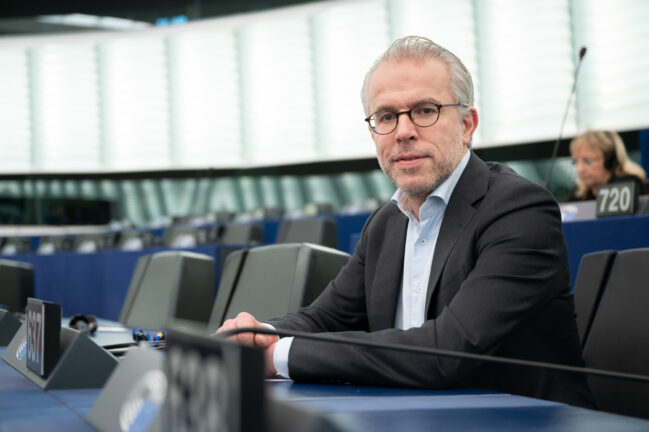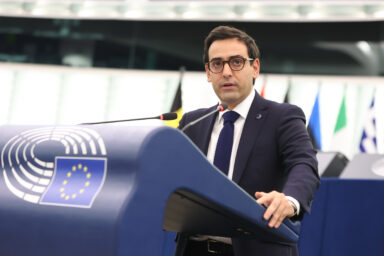Never in its short history has the EU faced threats as immediate as it does today. Yet the bloc’s common security and defence policy lies in tatters, Dutch Socialist MEP Thijs Reuten tells EU Perspectives. He blames national governments for setting individual priorities hobbling the Union’s collective security.
The deteriorating global security landscape presents arguably the most imminent existential threat to the European Union ever. In theory, European Common Security and Defence Policy (CSDP) should provide a speedy response to the challenge. In reality, it is barely limping. If not now, when? is the central message of the European Parliament’s report on the implementation of the legislation. It is a hot policy topic in the Security and Defence Committee.
“The formula for a good CSDP at EU level is: command-and-control and interoperability, military doctrine, political unity and resolve.” MEP Thijs Reuten (S&D/NED), rapporteur for the report, made his priorities clear in an interview with EUPerspectives.
What is for the EP, at this stage, the Common Security and Defence Policy?
The Parliament has consistently called to implement the Common Security and Defence Policy as the Treaty of Lisbon envisaged it. It was to have become the basis for a European Common Defence. It means enabling member states to guarantee each other’s security and come to each other’s aid. This goes far beyond the current implementation, which focuses mainly on CSDP missions and operations outside the EU. These, however, play an important role in maintaining peace and stability. They improve security sector governance, and helping partner countries build resilience to hybrid threats.
You might be interested
What is the state of play of the implementation?
The draft report stresses that the EU is not using the full potential of the CSDP. The Union has gained significant experience through its missions and operations, which have produced tangible results However, while there is still room for improvement in those missions, the report notes that, given the current security challenges and the need to reinforce collective security and deterrence, other objectives of the CSDP—related to a truly European defence—are even more urgent.
What are the main concerns — and obstacles?
The main obstacles are member states, who cling on to two things: NATO and national sovereignty. I respect that for many EU member states, NATO has been the cornerstone of their security, primarily because of the protection provided by the USA. But the times are changing and support from the US for NATO protection is less reliable. In my opinion, Europe should take responsibility for its own security, into its own hands. And that requires European solutions for defence.
We need to set aside national interests and first and foremost national driven spending on capabilities that are clearly European (shared, common) or that would be much cheaper if procured together. In the report I put some suggestions about starting to work on a European defence architecture and exploring some truly common (European) instruments and fresh ideas for procurement, command and control and further developing Article 42 (7).
(Editor’s note: The Article 42(7) refers to the mutual defence clause. It has been activated only once, by France in 2015 following the Paris terrorist attacks; there is no operational or military structure at EU level capable of making it truly effective; and, in generale, there is no common doctrine on how to interpret it – who decides, how coordination should work, and which capabilities should be mobilised.)
What does the “Europeanisation” of defence mean?
Real Europeanisation of defence—moving towards a functioning European Defence Union (EDU)—means setting aside national industrial interests, investing jointly (with the €1.5bn EDIP being currently the only real supranational element in new spending), and ensuring that the €650bn in new national defence budgets is not spent primarily according to national preferences. Instead, it should serve collective European priorities and projects.
What are the main ideas of the draft?
The main thought of the draft report builds, in my opinion, on the following political points. The current moment should be an architectural moment for the CSDP and a truly European organised defence. There is a clear need to define current Article 42(7), also linked to European pillar of NATO, which is an empty term. Also, Coalitions of the Willing outside EU legal framework undermine CSDP implementation and evolution. A lot more is feasible without treaty change: use PESCO not for developments but executive and operational cooperation. For what concerns the single defence market now: there’s fragmentation, lack of urgency shown through lack of joint procurements, intergovernmental solutions and so on.
For the proposal for EU to own military assets: we need the test of urgency and linking back to EDIP discussions. And more: mechanisms to use windfall profits and clawback funds to fund a European DARPA. Strengthening capabilities alone is not enough. In fact, it may not be our biggest weakness. The integration of Kyiv in the EU industry and in our defence is essential too.





